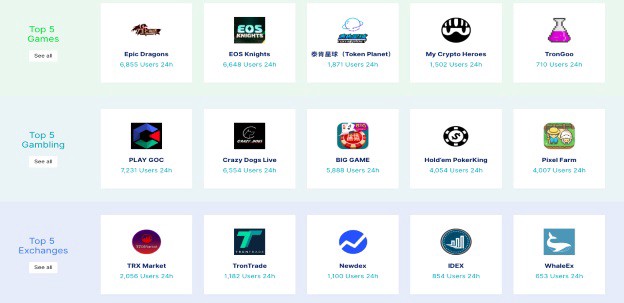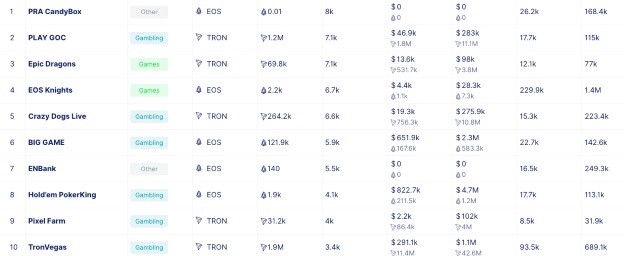Decentralized applications (Dapps) have taken off. Dappradar.com, the trusted authority on all things Dapps, has over 1800 listed dapps. And the activity is not restricted to the developer side; users and transactions are also steadily growing. Another player, State of Dapps reports the following:

ETH, EOS, and TRON are the major platforms for dapps, which now include apps for gaming, gambling, exchanges, and more. If we analyze the top 50 dapps, three are on ETH and the rest are on EOS and TRON.

While many “experts” have opined that Dapps are not drawing traction, the data disagrees. Admittedly, ETH has been slow to take off but EOS and TRON are leading the charts and growing aggressively. A note for caution: transactions on EOS and TRON networks are free due to which many developers use bots to generate fake volume to get attention. But Dappradar has been able to filter such activity and report close to actual numbers:

Ethereum, EOS and TRON: In detail
How Ethereum Works
ETH is famous for having given up on scalability to ensure security and true decentralization. But for dapps to work, scalability is the holy grail. High gas costs for ethereum has led to dapps in DEXs performing well (where security is paramount) as compared to gaming (where scalability and speed are critical).
How EOS Works
EOS network, long dubbed as the “Ethereum killer,” is not completely decentralized. It has 21 validators or ‘Witnesses’ who verify the transactions (Delegated Proof of Stake consensus algorithm). These are either the voted members or the ones with stake (depending on the currency they own). The transactions can be locked within a shorter time span. These witnesses are paid for voting and hence securing the network. If any witness does not fulfill his duty, he can be voted out. This has obvious advantages because scalability is no longer an energy guzzling long drawn process. Dapps will be able to onboard users at a much faster speed, and users will not be hostage to network congestions common on Ethereum. In return, they give up centralization, and if the nodes gang up, then the underlying platform is at their mercy.
How TRON works
TRON also works on a Delegated Proof of Stake consensus algorithm. It solves the scalability issue of Ethereum by not attempting to shard or sidechain but going back to the drawing board and scaling the main chainitself. This allows it to have a cost structure similar to an Amazon or Ebay, but with much more transparency. Still, it has the same issue as EOS–it is not truly decentralized. Chosen validators teaming up can lead to you being locked out.
Geographical Considerations
Governments in Asia are usually more authoritarian than their western counterparts. That is why cryptocurrencies were so popular among the wider public in Asia, and governments were quick to crackdown for reasons like “keeping order” and “capital controls.” But blockchain, like the internet, is now too mainstream to go back. These countries would prefer to have a structure that is more “governable” as compared to the freewheeling Ethereum. TRON and EOS fit the bill perfectly. Hence, they are encouraging EOS and TRON, and discouraging more decentralized platforms like Ethereum. This same scenario played out in Baidu vs. Google, and other similar internet companies that were encouraged and supported because they were willing to follow local rules.
Scalability Trilemma: Vitalik Buterin, Ethereum founder, coined a term called “Scalability Trilemma” that addresses the issues of blockchain technology. He believes that any blockchain will be able to achieve any two traits out of three at one time:
- Decentralization: This is the core principal in which each participant has access to the resource. It allows all members to take part in the decentralized ecosystem.
- Security: This is defined as immunity towards hackers or attackers who can have access to the underlying resource.
- Scalability: It is the ability to process transactions at scale, irrespective of the network. For instance, a public blockchain should be able to handle millions of users on the network.
Cost Comparison
| Elements | ETH | EOS | TRON |
| Market Price | $147.35 | $3.63 | $0.025 |
| Market capital (Billion) | $15.5 | $3.3 | $1.07 |
| Average transaction fee | 0086ETH | (Approx. $1.27 USD) | NA.1% ( Approx. 0) |
| Sum of all Dapps | 2329 | 216 | 49 |
Source: BitInfoCharts
Analysis of the table
Ethereum is expensive because it is completely decentralized. But, obviously, operators prefer to have lower transaction time and costs for better user experience. Gambling and gaming dapps don’t need the same amount of security as an exchange dealing in stock trading, settling, money transfers, etc. This has led to the proliferation of gaming and gambling dapps on TRON and EOS.
The application sophistication is higher on Ethereum (i.e. it comes with more designs in the games, more resources etc.), but it can take almost six months to build an Ethereum dapp. On the other hand, EOS and TRON are comparatively cheaper. But the quality of graphics and designing are low. It takes only a few weeks to make a simple gambling dapp on these platforms.
Other Dapp Platforms
Ethereum, TRON, and EOS as dapps are not the only platforms. Other dapp platforms like… please continue reading on Blockchain Times.